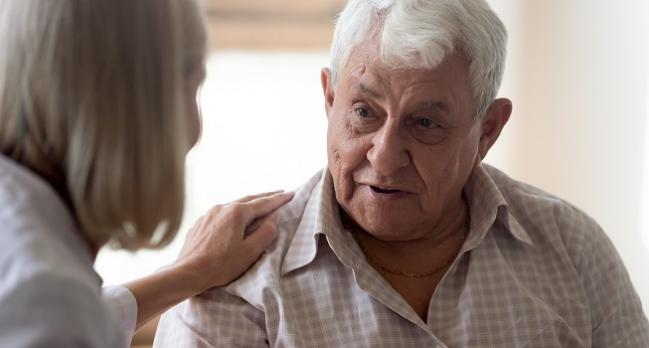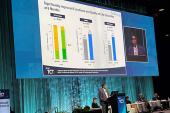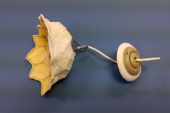‘Reasonable’ Results With TMVR for Mitral Regurgitation: CHOICE-MI
Real-world data point to durable effects on MR, but Alison Duncan says transcatheter MV replacement has a ways to go.

In the CHOICE-MI registry, TMVR using a range of 10 different devices, the vast majority via transapical access, was associated with high technical success (> 95%) and a relatively low risk of procedural complications. Additionally, nearly three-quarters of patients remained free from MR at 1-year follow-up.
Still, access-site complications were relatively common (9.6%) and roughly 40% of the 229 high-risk patients who underwent TMVR had either died or were hospitalized for heart failure (HF) at 1 year, a rate that is relatively high but lower than that seen in patients who received medical therapy alone, reported Alison Duncan, MBBS, PhD (Royal Brompton Hospital, London, England), during a hotline session this week at PCR London Valves 2021.
“Access-site complications are a potential downside to transapical TMVR, but one of the pluses is the very predictable and durable elimination of mitral regurgitation,” Duncan told TCTMD. “That seemed to be the case in our study at 30 days and this was sustained to 1 year. TMVR produced elimination, not just a reduction, of mitral regurgitation in the vast majority of patients, irrespective of their [MR] etiology. To us, it seems that TMVI may be a reasonable alternative for patients with severe symptomatic MR, who are considered unsuitable for standard mitral regurgitation therapies following a discussion with the heart team.”
In Europe, Tendyne (Abbott) is the only device with CE Mark approval for transcatheter mitral valve replacement. It is also the device with the longest follow-up to date, including 2-year data from the Global Feasibility Study of 100 patients at high/prohibitive risk for surgery, and 6-year follow up from a small compassionate-use case series. Data from other, small feasibility studies testing other systems have been presented, but follow-up is shorter and fewer patients have been treated. Duncan said operators have been implanting Tendyne for at least 7 years now, but the purpose of this analysis was to look beyond that device and to assess the real-world outcomes of symptomatic patients with at least moderate MR who were at prohibitive risk for surgery or anatomically unsuitable for TEER.
“Right now, it’s hard to define the exact space where transcatheter mitral valve implantation fits,” said Duncan. “The gold standard, certainly for primary MR, is surgery and TEER may be considered in inoperable symptomatic patients with suitable anatomy. For patients with secondary MR, TEER is a class II indication. TMVR made the ESC/EACTS guidelines for the first time in autumn 2021, but only to say that it is the subject of investigation and clinical data is limited. The current level of evidence favors surgery or edge-to-edge repair.”
Right now, according to one review, there are more than 30 TMVR devices in development, the majority of which are in early safety and feasibility studies.
Investigator-Initiated Registry Data
CHOICE-MI is an investigator-initiated, multicenter registry evaluating outcomes of patients with significant MR who are considered high risk for surgery and have anatomy that makes them suboptimal candidates for TEER. Between 2014 and 2021, there were 229 patients treated with a range of TMVR devices including Tendyne, Intrepid (Medtronic) and Tiara (Neovasc).
The majority of patients (58.4%) had secondary MR, 28.8% had primary MR, 12.8% had mixed etiology, and 11.8% had mitral annulus calcification (MAC). Overall, patients were elderly (mean age 76 years) and more than one-third were female. The mean STS-PROM and EuroSCORE II scores were 5.7% and 6.3%, respectively; 36% had undergone a previous CABG surgery. Roughly one-quarter of patients had NYHA class IV symptoms and 55.3% had chronic kidney disease.
The procedure was successful in 95.2% of patients and the rate of procedural mortality was 1.8%. At 30 days, however, 9.9% of patients had died. In terms of complications, left ventricular outflow tract obstruction (LVOT), which Duncan described as the “bane of transcatheter mitral valve implantation,” was low at 3.2%, which is likely the result of careful eligibility screening. Valve malposition was documented in 3.7% of patients and conversion to surgery was required in 2.8% of cases. As noted, access-site complications occurred in 9.6% of patients, a risk more pronounced in patients with MAC, and 7.5% required reintervention for bleeding. Acute kidney injury was reported in 15.4% of patients.
“There was a very high rate of renal failure, but more than half of patients had chronic kidney disease before the procedure was initiated,” said Duncan.
At 1 year, the primary composite endpoint of all-cause death or HF hospitalization was 39.2% and there was no significant difference seen in patients with primary MR, secondary MR, or mixed MR. At discharge, 83.9% of patients had residual MR less than 1+. By 1 year, that number was 72.2%. The CHOICE-MI researchers also tracked patients deemed ineligible for transcatheter replacement. Of these, 240 were treated with medical therapy and 47.9% had either died or were hospitalized for HF at 1 year.
What’s Needed Next
To TCTMD, Duncan said the clinical outcomes to date with Tendyne are good, but it’s still early days for the field. In October, Duncan published long-term data on five patients who received the device at their center, four of whom were alive at 6 years. However, for TMVR to grow and reach wider acceptance, there will be a need to transition from transapical systems to the transfemoral/transeptal approach.
“We’re quite a ways from achieving that right now,” said Duncan. “TMVR devices are large, require large sheath sizes, and this creates issues for transeptal puncture, maneuvering in the left atrium, and ensuring good device sealing in the MV annulus. For TMVR to gain more widespread acceptance, it would be great if we could perform these procedures without a lower risk of access-site complications by going transfemorally. We’re not there yet.”
At the moment, several TMVR systems are being developed for use via a transseptal/transfemoral approach, including CardiAQ/EVOQUE and Sapien M3 (both Edwards Lifesciences), the latter of which is a modified Sapien 3 TAVI device.
Abbott has launched the 1,000-patient SUMMIT trial investigating the safety and feasibility of Tendyne in patients with symptomatic, moderate-to-severe MR. The study includes a comparison of Tendyne against TEER in selected patients with MitraClip (Abbott) indications and a nonrandomized cohort where patients are treated solely with Tendyne. Results of the study are expected in 2022.
Michael O’Riordan is the Managing Editor for TCTMD. He completed his undergraduate degrees at Queen’s University in Kingston, ON, and…
Read Full BioSources
Duncan A, Ludwig S, Ali BW, et al. One-year outcomes after transcatheter mitral valve implantation: results from the CHOICE-MI registry. Presented at: PCR London Valves 2021. November 24, 2021.
Disclosures
- Duncan reports honoraria from/consulting for Abbott, Edwards Lifesciences, and Medtronic.





Comments